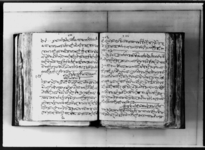A bhanāi of a letter by the king to Kājī Aṃbarasīṃ Thāpā re the sending of a sword (VS 1862)
ID: RRC_0006_0604
Edited and
translated by Astrid Zotter
in collaboration with
Rajan Khatiwoda
Created: 2016-01-26;
Last modified: 2018-06-15
For the metadata of the document, click here
The accompanying edition, translation/synopsis and/or commentary are available under the terms of the Creative Commons Attribution-ShareAlike 4.0 International License
Abstract
This is the main body of a letter (i.e. excluding the initial formalities) in which the sender (very probably the king) announces to Kājī Aṃbarasīṃ Thāpā that a sword has been sent to him on Vijayādaśamī through Subedāra Candrabhāna Khatrī. The receiver is instructed to carry the sword at his waist to ensure future victory.Diplomatic edition
[552]
९९४1काजीअंवरसींथापावर्मा2चीठीकोभनाइ
3उप्रान्तमेरावाहुलीकोतरोवारवीजय़ादश[?]
4कोसाईतपठाय़ावढीय़ाहोलाभनीजैसीहरु
5लेवींतीगर्दाउर्दीदीमेराकंवरमाराषीषड्ग
6स्थापनामावीधीपुर्वककोपुजागरीषुरासान
7तरोवारचंद्रभानषत्रीसुवेदारकाहाततीमीछे
8उपुगन्य़ागरीपठायेकोछेआफनासाथकमरमा
9राषन्य़ागरय़ोतरोवारकंवरछज्यालतीनीष्टै
[553]
1सीतरहन्य़ागर्नुकाजपर्य़ामापनीकंवरैमारहोसफ2तेहहुन्य़ाछमिति१८६२सालमीतीआश्वींसुदी१०
3रोस५शु
Translation
[552]
[no.] 994.1
[To:] KājīAṃvara Sīṃ Thāpā Varmā.2
The main body of the letter:3
Uprānta: As the astrologers (jaisīharu) have given the advice that it will be very good if a [single-]handed sword of mine (lit. “my hand’s sword” mero bāhulīko tarovāra) is sent [to you at the] auspicious moment (sāīta) of Vijayādaśamī, [I have] given [the necessary] orders, and a Khurāsān4 sword of mine, which [I] kept at [my] waist while performing worship (pūjā) according to the rules on khaḍgasthāpanā, has been sent to reach you through the hands of Subedāra Caṃdrabhāna Khatrī. Keep it with you at your waist. Remain in a state of devotion (niṣṭaisīta) as long as this sword is [at your] waist.
[553]
Let it remain at [your] waist even when there are official tasks [to do]. There will surely be victory (phateha).Thursday, the 10th of the bright fortnight of Āśvina [in the Vikrama] year 1862 (1805 CE).5 Auspiciousness.
Commentary
The document has previously been translated by M.C. Regmi (1989: 50). He renders niṣṭaisīta rahanyā as “remain ritually pure” and kāja paryāmā as “when fighting occurs.” These translations render what may have been intended, but are at least imprecise. Even more loose is Regmi’s rendering of the passage khaḍgasthāpanāmā ... pujā garī.
“Establishing the sword” (khaḍgasthāpanā) was a key part of the royal Navarātra celebrations performed during the Malla dynasty of the Kathmandu Valley (A. Zotter forthcoming). It has usually been performed on Mahāṣṭamī, the eighth day of the autumnal Navarātra. As the document speaks about the sending of the sword on Vijayādaśamī (i.e. the climactic day of the festival, which under the Mallas featured a khaḍgajātrā, a sword procession, with the empowered sword being paraded through town), it may be evidence of the Śāhas’ adoption or adaptation of that part of the festival. These practices may, however, also be connected with the Bhadrakālīpūjā, which Chaulagain (2013) calls “[o]ne of the most esoteric rituals” (ibid.: 155) and was performed for the Śāha kings in the night of the seventh day of the Navarātra aka. Dasaĩ festival. In its course “weapons employed during the conquest of Gorkhā in 1559 and of the Kathmandu Valley in 1767/8” are “smeared with vermillion powder and raised (implanted) … in the pūjā room for khaḍgasiddhi” (ibid.: 156).

